





Well, I think we are almost there, but not quite, this quilt still has a few secrets to reveal! I removed the scruffy cream centre panel from the green floral, presuming it to be the reverse of the quilt, expecting to find the cream panel covering the damaged remains of the madder dyed layers, but no, it was very damaged green floral, so instead of being part of the outer layer, the green floral(GF) was part of the second to last layer, the scruffy cream fabric was the final layer.
Once the few quilting stitches were removed from the damaged GF - incidentally, the pattern of stitches was a few large, simple squares and some vertical rows of quilting - a different pattern of stitching was immediately revealed underneath, tiny squares set like diamonds, this can clearly be seen photos! What is also very clear, is that the C&J layer is on top of the R&S layer, therefore the C&J layer is the 3rd stage, and the R&S the 4th. But now we have a 5th layer peeping through, a finely woven, not printed, red and blue stripe fabric, which seems to be sandwiched between two layers of fleece, right in the middle, in 2 or more separate panels. It also seems to have another piece of fabric stitched to it, a deep indigo woven cloth of some sort!
What now seems clearer is the order in which the fabrics so far revealed were used, and therefore, it may soon be possible to come up with a timeline of sorts for this pretty little quilt. Next time I look at it and unpick it a little more, I shall investigate the striped and indigo fragments, they look really exciting, they could be the earliest fabrics we have here.
Please click on the photos to see the supersized pics to enjoy the details fully.
Once the few quilting stitches were removed from the damaged GF - incidentally, the pattern of stitches was a few large, simple squares and some vertical rows of quilting - a different pattern of stitching was immediately revealed underneath, tiny squares set like diamonds, this can clearly be seen photos! What is also very clear, is that the C&J layer is on top of the R&S layer, therefore the C&J layer is the 3rd stage, and the R&S the 4th. But now we have a 5th layer peeping through, a finely woven, not printed, red and blue stripe fabric, which seems to be sandwiched between two layers of fleece, right in the middle, in 2 or more separate panels. It also seems to have another piece of fabric stitched to it, a deep indigo woven cloth of some sort!
What now seems clearer is the order in which the fabrics so far revealed were used, and therefore, it may soon be possible to come up with a timeline of sorts for this pretty little quilt. Next time I look at it and unpick it a little more, I shall investigate the striped and indigo fragments, they look really exciting, they could be the earliest fabrics we have here.
Please click on the photos to see the supersized pics to enjoy the details fully.

























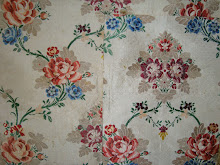





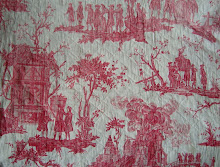
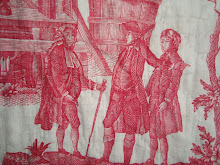




































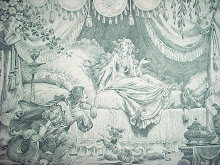







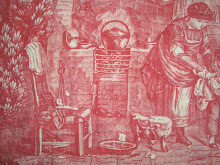





This is so fascinating! What an amazing project. I can't wait for you to document some of these textiles. I am also very curious about the story...do you think this had been an heirloom passed down, repaired, reinforced with another layer, etc.? Or perhaps it was just passed off over time to other families unrelated. I suppose it is hard to decipher. You are doing a superb job with the photos and process, and I am learning as you undo this mystery. What a treat to be able to vicariously participate.
ReplyDeleteI am really not at all sure about its cultural history, we will probably never know for sure, but I have some thoughts, I agree with you, it could have been an heirloom, passed through several generations, but it also could have been a slightly higher status piece originally, then possibly passed on to a servant or poorer relative to cut into a fresh base to cover with new fabric. My instincts at the moment are suggesting to me that the woven striped fabrics may be a lot older than the madder dyed printed cottons. The next stage will be to completely dismantle it as far as I can, eg, remove the outer layers completely, and see what remains! I am very excited about this, it may have some interesting surprises for us! Thank you so much for your input, between us, we are coming up with some very interesting ideas.
ReplyDeleteThis quilt has proved to be a facinating time machine. It reminds me of archeology or geology, looking at which layer cross-cuts another and building up a stratigraphy. So many stories it must hold. It must take a lot of time, carefully unpicking it as you have. Very exciting, thanks X
ReplyDeleteI am glad you are enjoying it! It would be quite boring to a lot of people, but the cultural history here is very fascinating, and the potential stories it contains manifold. I like your comparison the geology and archaeology, it is a lot like that! xx
ReplyDelete